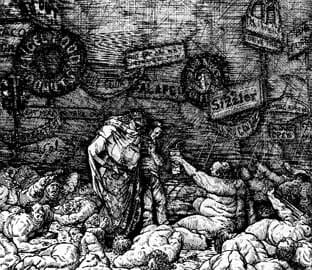Dante’s Inferno

One only need look at the cover of Sandow Birk and Marcus Sanders’ adaptation of Dante’s Inferno to realize that this project is not your average translation. It is a self-conscious update, both visually and textually. The idea of modernizing the Inferno isn’t unwelcome; while most serious writing was still done in Latin, Dante himself wrote in vernacular Italian, leavening his epic liberally with contemporary—even personal—references. In the succeeding 700 years or so, Dante’s work has reached iconic status; most people at least know of the Inferno, even if they haven’t read it. So anything that can make Dante’s work more immediate, that can strip away the aura of Important Literature—less Obligation, more Pleasure—is desirable.
-

-

-

-

-

-

-

-

-

-

-

-

-

-

-

-

-

-

-

-

-

-

-

-

-

-

-

-

-

-

-

-

-

-

-

-

-

-

-

-








































